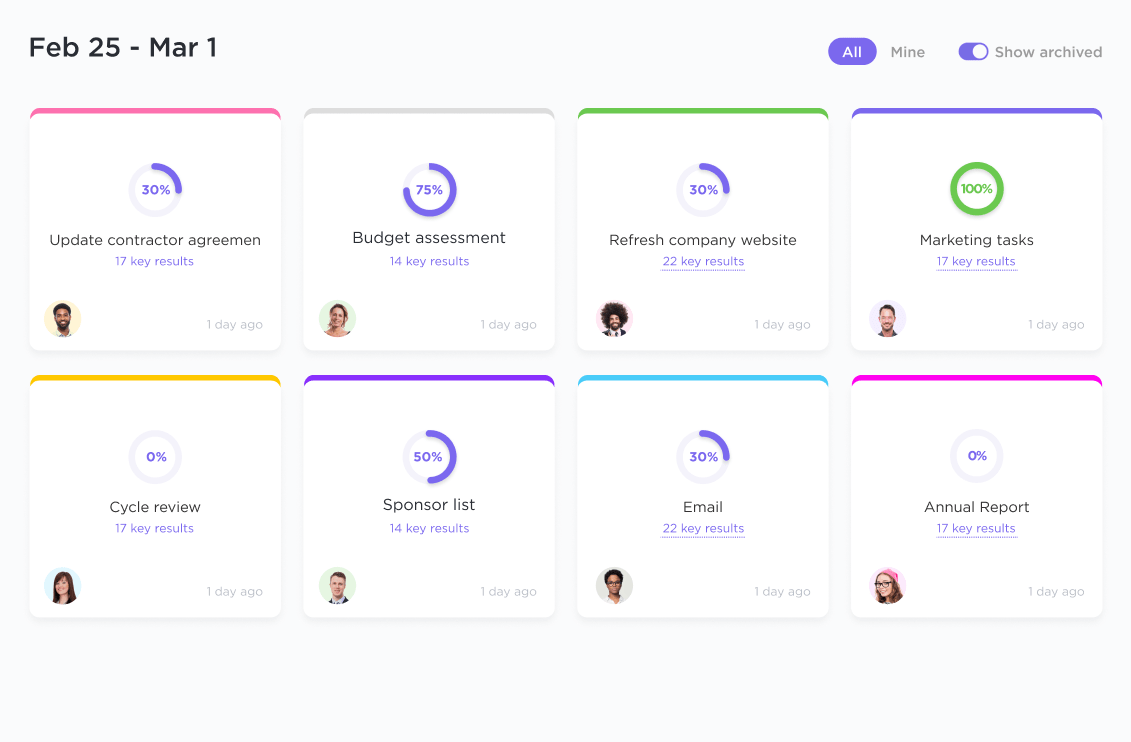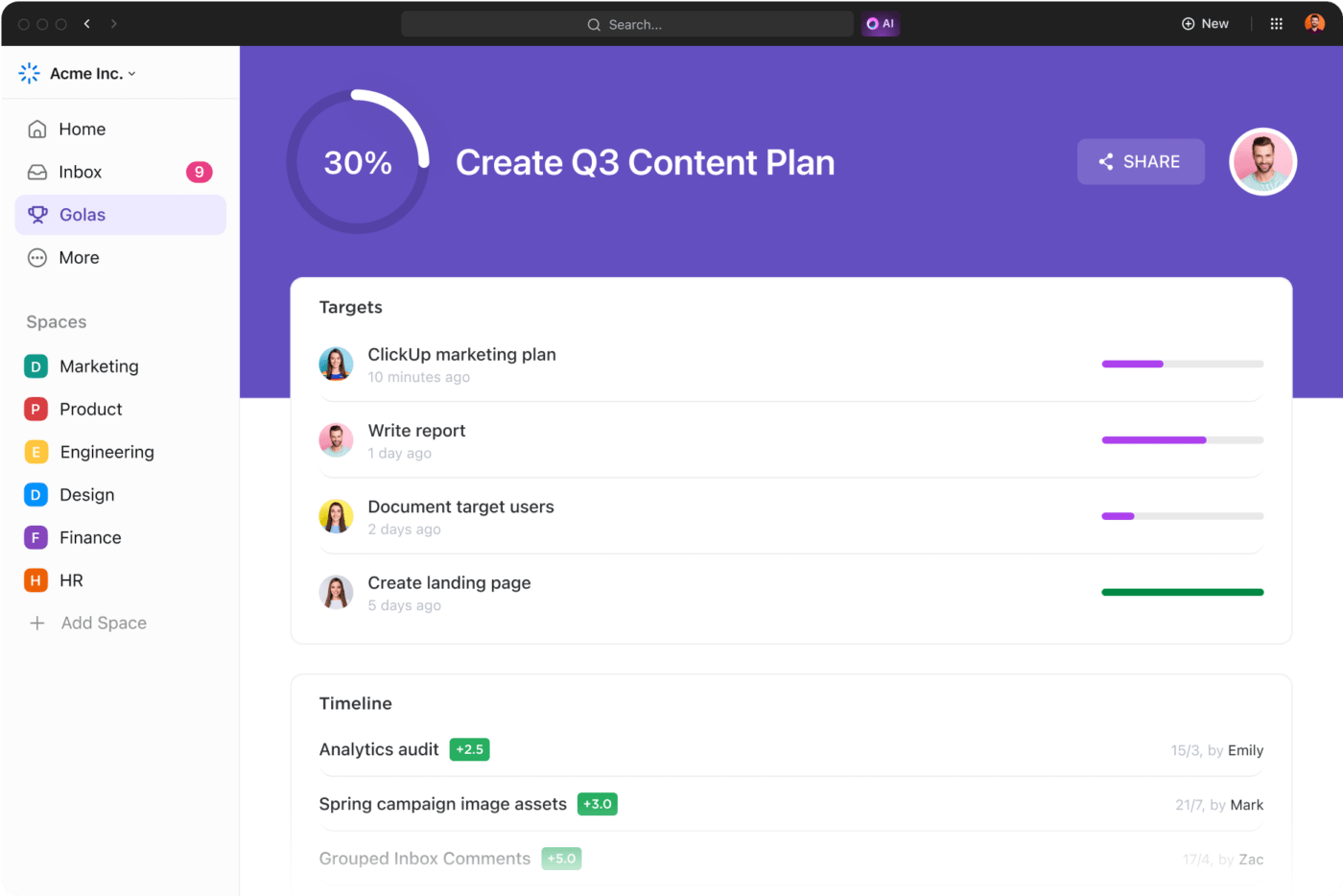How To Set Project Goals And Mistakes To Avoid (+ Templates)

Sorry, there were no results found for “”
Sorry, there were no results found for “”
Sorry, there were no results found for “”
Planning is an essential part of project preparation. However, even the best-laid plans quickly go astray without a clear purpose.
Here’s where project goals enter the spotlight.
Project goals are the compass that keeps the project team focused and aligned. They help concentrate everybody’s efforts in a shared endeavor and keep teams working in the same direction. Here’s a detailed look at project goals and how to set killer ones!
A project goal is a statement that helps define and document a project’s desired result or outcome. It is the primary thought or idea that initiated the project.
Like any other goal, project goals should fit the SMART framework to be more effective. SMART is a goal-setting technique that requires project goals to be:
Say you notice a market gap for plant-based mock meat. Developing three different plant-based mock meat products and launching them to your target audience within the next six months would be a project goal.
Similarly, maybe you notice long wait times in the customer service department. A project goal could be to reduce wait times by 25%.
These are just a few examples to get us started. In the later sections, we’ll explore project goals examples in detail.
Project goals are aspirational, high-level statements highlighting a project’s plans. This may sound similar to project objectives. After all, project objectives are also specific, measurable actions that contribute to achieving the project goal. Such a close relationship may cause project managers to use the terms interchangeably.
However, there is a difference between a project goal and a project objective. The former is the end state, while the latter is the road to getting there. Naturally, this would make project objectives more specific and more actionable while also being quantitatively and qualitatively measurable when compared to project goals that can afford to be vague.
Here’s a quick example:
Project management goals offer clear direction, purpose, and focus. They bring project team alignment, strategize resource allocation, and aid in deadline management. In simple words, project goals are the foundation for organizational success. Here’s a more in-depth look at what a project goal has to offer:

Also Read: Project Scope Templates and Scope Document Examples
We’re sharing a few examples of project goals and project objectives that you can add to your goal-setting templates for reference. We’ve tried to be as comprehensive as possible and cover various eventualities where goal-setting may be prominent.
Feel free to tweak these based on your requirements. Hopefully, this list of project goal examples will inspire you to set realistic project goals.
So, let’s get started:
Highly engaged and satisfied employees are the backbone of a successful business. So, a project goal focusing on employees would look something like this:
Project objectives:
Project objectives:
Project objectives:
A project goal for customers often focuses on enhancing customer experience, earning loyalty, and delivering customer satisfaction. Here are a few examples of such goals:
Project objectives:
Project objectives:
Project objectives:
Looking to streamline workflows and operations to fuel efficiency and cost-effectiveness? Here are a few SMART goals that you can set to meet such business objectives:
Project objectives:
Project objectives:
Project objectives:

If you’re aiming to increase revenue, reduce operational overheads, improve profitability, and optimize cash flow within a project budget, consider adding the following examples to the goal-setting process:
Project objectives:
Project objectives:
Project objectives:
Want to leverage technology to power innovation, improve business operations, boost security, and tap into accelerated growth? Here are some project management goals for these business objectives:
Project objectives:
Project objectives:
Project objectives:
Effective goal-setting is the key to achieving the desired result. To hedge the bets in your favor, here are some best practices that you can follow to set goals that improve your chances of reaching the target:

Since we’ve covered the best practices for goals, it’s equally vital to review some common pitfalls associated with them. Here’s a list of some of the mistakes to avoid:
ClickUp is a free, full-featured project management software that needs no introduction. Since this all-in-one solution enhances every aspect of project management, it is only natural that it is also every project manager’s ally for goal setting.
Any project manager can take charge of their project management goal using ClickUp Goals.

This dedicated tool facilitates a clear understanding of project objectives to ensure that all other elements work in the same direction to achieve company goals. You can craft a SMART project objective or goal, identify dependencies and resource conflicts, break down large goals into smaller, measurable action items, ensure alignment with larger goals, prioritize goals and objectives, and track real-time progress.
Simply put, ClickUp Goals helps you embrace the best goal-setting practices and bypass the mistakes discussed above!
While Goals is an absolute beast on its own, wait till you see the expansive library of customizable templates. There’s a template to set realistic project goals for every project imaginable. Don’t believe us? Here are a few to get you started.
ClickUp Project Tracker Template
Stay on top of tracking your project goals and objectives with this intermediate-level template that offers an overview of tasks, deadlines, and dependencies. This template enables streamlined project management by categorizing tasks into specific stages and allowing team members to visualize and schedule their tasks.
ClickUp Project Deliverables Template
Keep an eye on project deliverables using a dedicated template that helps you manage tasks, milestones, and hand-offs. Using this template, you can efficiently assign tasks, prioritize them based on importance, and set clear deadlines, ensuring the project stays on track and deliverables are met.
ClickUp Project Management Template
Master organization and efficiency with a pre-built template for task management and progress monitoring. This template facilitates efficient collaboration and empowers project, program, and portfolio managers to deliver results swiftly.
Create specific, measurable, achievable, relevant, and time-bound goals using this standardized template. By breaking down complex goals into smaller, manageable steps, you can effectively track progress, stay motivated, and identify potential obstacles. This structured approach transforms overwhelming aspirations into achievable milestones, ultimately leading to greater success.
That’s a wrap on all things project goals. We’ve gone over the definitions, compared the difference between project goals and objectives, and understood the importance of project goals, along with some examples. There are also the best practices and mistakes to avoid sections that’ll help you master how you define realistic goals.
Remember, clear objectives, effective planning, and dedicated execution help you accomplish your goals and lead your team to success. A great way to actualize this would be through a powerful project management tool—like ClickUp.
Start your journey to project management excellence today by signing up on ClickUp!
© 2025 ClickUp